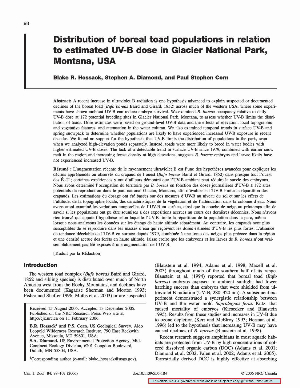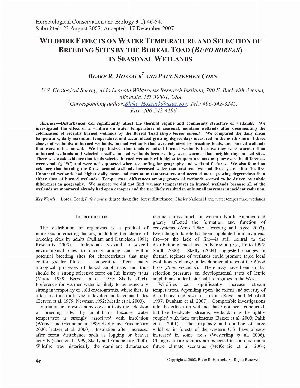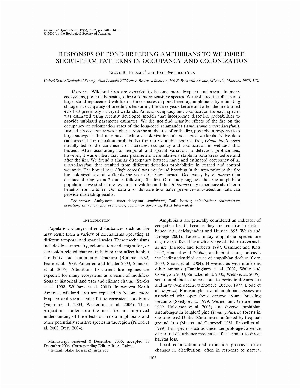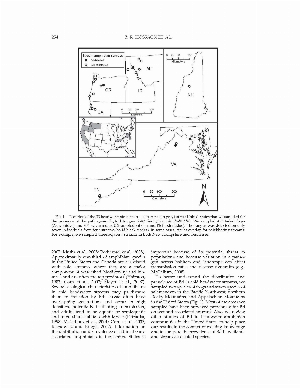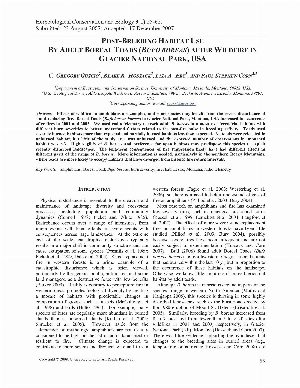Search ARMI Database
Search term(s)
Contribution Number
Search Results
877 record(s) found.
Papers & Reports Parasite (Ribeiroia Ondatrae) infection linked to amphibian malformations in the western United States
Authors: P TJ Johnson; K B Lunde; E M Thurman; E G Ritchie; S N Wray; D R Sutherland; J M Kapfer; T J Fest; Jay Bowerman; Andrew R Blaustein
Date: 2002 | Outlet: Ecological Monographs 72(2): 151-168
Papers & Reports Hyla cinerea (green treefrog): Predation
Authors: B M Jeffery; Hardin J Waddle; A J Maskell
Date: 2004 | Outlet: Herpetological Review 35: 158
Describes the predation of green treefrogs by the Okefenokee fishing spider
Papers & Reports Temporal Organization of an Anuran Acoustic Community in a Taiwanese Subtropical Forest
Authors: M Hsu; Y C Kam; Gary M Fellers
Date: 2006 | Outlet: Journal of Zoology 269: 331-339
Papers & Reports Effectiveness of amphibian monitoring techniques in a Taiwanese subtropical forest
Authors: M Hsu; Y C Kam; Gary M Fellers
Date: 2005 | Outlet: Herpetological Journal 15: 73-79
Papers & Reports Lack of significant changes in the herpetofauna of Theodore Roosevelt National Park, North Dakota, since the 1920s
Authors: Blake R Hossack; David S Pilliod; P. Stephen Corn
Date: 2005 | Outlet: American Midland Naturalist 154: 423–432
We surveyed 88 upland wetlands and 12 1-km river sections for amphibians in Theodore Roosevelt National Park, North Dakota, during 2001–2002 to gather baseline data for future monitoring efforts and to evaluate changes in the distribution of species. We compared our results to collections of herpetofauna made during 1920–1922, 1954 and 1978–1979. The boreal chorus frog (Pseudacris maculata) was the most common amphibian in upland wetlands, followed by the tiger salamander (Ambystoma tigrinum), Woodhouse’s toad (Bufo woodhousii), northern leopard frog (Rana pipiens), plains spadefoot (Spea bombifrons) and the Great Plains toad (B. cognatus). Bufo woodhousii was the only species that bred in the river. Our records for reptiles are less complete than for amphibians but no losses from the community are evident. The herpetofauna in Theodore Roosevelt National Park seems unchanged during at least the last half-century and likely since 1920–1922.
Papers & Reports Distribution limits of Batrachochytrium dendrobatidis: a case study in the Rocky Mountains, USA
Authors: Blake R Hossack; Erin Muths; Chauncey W Anderson; Julie A Kirshtein; P. Stephen Corn
Date: 2009 | Outlet: Journal of Wildlife Diseases 45: 1198–1202
Knowledge of the environmental constraints on a pathogen is critical to predicting its dynamics and effects on populations. Batrachochytrium dendrobatidis (Bd), an aquatic fungus that has been linked with widespread amphibian declines, is ubiquitous in the Rocky Mountains. As part of assessing the distribution limits of Bd in our study area, we sampled the water column and sediments for Bd zoospores in 30 high-elevation water bodies that lacked amphibians. All water bodies were in areas where Bd has been documented from neighboring, lower-elevation areas. We targeted areas lacking amphibians because existence of Bd independent of amphibians would have both ecologic and management implications. We did not detect Bd, which supports the hypothesis that it does not live independently of amphibians. However, assuming a detection sensitivity of 59.5% (based on sampling of water where amphibians tested positive for Bd), we only had 95%confidence of detecting Bd if it was in $16% of our sites. Further investigation into potential abiotic reservoirs is needed, but our results provide a strategic step in determining the distributional and environmental limitations of Bd in our study region.
Papers & Reports Thermal characteristics of amphibian microhabitats in a fire-disturbed landscape
Authors: Blake R Hossack; Lisa A Eby; P. Stephen Corn
Date: 2009 | Outlet: Forest Ecology and Management 258: 1414–1421
Disturbance has long been a central issue in amphibian conservation, often regarding negative effects of logging or other forest management activities, but some amphibians seem to prefer disturbed habitats. After documenting increased use of recently burned forests by boreal toads (Bufo boreas), we hypothesized that burned habitats provided improved thermal opportunities in terrestrial habitats. We tested this hypothesis by conducting a radio telemetry study of habitat use (reported previously) and by using physical models that simulated the temperature of adult toads. We deployed 108 physical models in and adjacent to a 1-year old burn using a fully-replicated design with three burn severities (unburned, partial, high severity) and four microhabitats (open surface, under vegetation, under log, in burrow). Model temperatures were compared to a range of preferred temperatures in published studies. We found 70% more observations within the preferred temperature range of B. boreas in forests burned with high severity than in unburned areas. Burned forest was warmer than unburned forest across all microhabitats, but the largest relative difference was in burrows, which averaged 3 8C warmer in high-severity burn areas and remained warmer though the night. More than twice as many observations were within the preferred temperature range in high-severity burrows than in unburned burrows. Areas burned with high severity were still warmer than unburned forest 3 years after the fire. Habitat use of toads during the concurrent radio telemetry studymatched that predicted by the physical models. These results suggest there are fitness-linked benefits to toads using burned habitats, such as increased growth, fertility, and possibly disease resistance. However, increased soil temperatures that result from wildfire may be detrimental to other amphibian species that prefer cooler temperatures and stable environments. More broadly, our data illustrate the use of physical models to measure and interpret changes that amphibians may experience from disturbance, and highlight the need for research linking vital rates such as growth and survival to disturbance.
Papers & Reports Distribution of the boreal toad populations in relation to estimated UV-B dose in Glacier National Park, Montana, USA
Authors: Blake R Hossack; S Diamond; P. Stephen Corn
Date: 2006 | Outlet: Canadian Journal of Zoology 84: 98–107
A recent increase in ultraviolet B radiation is one hypothesis advanced to explain suspected or documented declines of the boreal toad (Bufo boreas Baird and Girard, 1852) across much of the western USA, where some experiments have shown ambient UV-B can reduce embryo survival. We examined B. boreas occupancy relative to daily UV-B dose at 172 potential breeding sites in Glacier National Park, Montana, to assess whether UV-B limits the distribution of toads. Dose estimates were based on ground-level UV-B data and the effects of elevation, local topographic and vegetative features, and attenuation in the water column. We also examined temporal trends in surface UV-B and spring snowpack to determine whether populations are likely to have experienced increased UV-B exposure in recent decades. We found no support for the hypothesis that UV-B limits the distribution of populations in the park, even when we analyzed high-elevation ponds separately. Instead, toads were more likely to breed in water bodies with higher estimated UV-B doses. The lack of a detectable trend in surface UV-B since 1979, combined with earlier snow melt in the region and increasing forest density at high elevations, suggests B. boreas embryos and larvae likely have not experienced increased UV-B.
Papers & Reports Divergent patterns of abundance and age-class structure of headwater stream tadpoles in burned and unburned watersheds
Authors: Blake R Hossack; P. Stephen Corn; D Fagre
Date: 2006 | Outlet: Canadian Journal of Zoology 84: 1482–1488
Wildfire is a potential threat to many species with narrow environmental tolerances, including the Rocky Mountain Tailed Frog (Ascaphus montanus Mittleman and Myers, 1949), which inhabits a region where the frequency and intensity of wildfires is expected to increase. We compared pre- and post-fire counts of tadpoles in 8 streams in northwest Montana to determine the effects of wildfire on A. montanus. All streams were initially sampled in 2001, 2 years before 4 of them burned in a large wildfire, and were resampled during the 2 years following the fire. Counts of tadpoles were similar in the two groups of streams before the fire. After the fire, tadpoles were almost twice as abundant in unburned streams than in burned streams. The fire seemed to have the greatest negative effect on abundance of age-1 tadpoles, which was reflected in greater variation in same-stream age-class structure compared to unburned streams. Despite the apparent effect on tadpoles, we do not suspect the wildfire is an extirpation threat to populations in the streams we sampled. Studies spanning a chronosequence of fires and in other areas are needed to assess effects on A. montanus streams and to determine the severity and persistence of effects on populations.
Papers & Reports Wildland fire and seasonal wetlands: effects on water temperature and selection of breeding sites by the boreal toad (Bufo boreas)
Authors: Blake R Hossack; P. Stephen Corn
Date: 2008 | Outlet: Herpetological Conservation and Biology 3: 46–54
Disturbances can significantly affect the thermal regime and community structure of wetlands. We investigated the effect of a wildfire on water temperature of seasonal, montane wetlands after documenting the colonization of recently burned wetlands by the Boreal Toad (Bufo boreas boreas). We compared the daily mean temperature, daily maximum Temperature, and accumulated growing degree·days measured on the north shore of three classes of wetlands: unburned wetlands, burned wetlands that were colonized by breeding toads, and burned wetlands that were not colonized. We hypothesized that toads colonized burned wetlands because they were warmer than unburned wetlands and selected specific burned wetlands because they were warmer than neighboring burned sites. There was weak evidence that toads selected burned wetlands with higher temperature maxima; however, the differences were small (≤ 1°C) and were not supported when accounting for geography and wetland features. We also found no evidence that burning the forest around wetlands increased water temperatures two and three years after the fire. Unburned wetlands had higher daily mean and maximum temperatures and accrued more growing degree·days than either class of burned wetlands. Temperature differences among groups of wetlands seemed to be driven by subtle differences in geography. We suspect we did not find warmer temperatures in burned wetlands because all of the wetlands we monitored already had open canopies and the fire likely resulted in only small increases in incident radiation.
Papers & Reports Responses of pond-breeding amphibians to wildfire: short-term patterns in occupancy and colonization
Authors: Blake R Hossack; P. Stephen Corn
Date: 2007 | Outlet: Ecological Applications 17: 1403–1410
Wildland fires are expected to become more frequent and severe in many ecosystems, potentially posing a threat to many sensitive species. We evaluated the effects of a large, stand-replacement wildfire on three species of pond-breeding amphibians by estimating changes in occupancy of breeding sites during the three years before and after the fire burned 42 of 83 previously surveyed wetlands. Annual occupancy and colonization for each species was estimated using recently developed models that incorporate detection probabilities to provide unbiased parameter estimates. We did not find negative effects of the fire on the occupancy or colonization rates of the long-toed salamander (Ambystoma macrodactylum). Instead, its occupancy was higher across the study area after the fire, possibly in response to a large snowpack that may have facilitated colonization of unoccupied wetlands. Naive data (uncorrected for detection probability) for the Columbia spotted frog (Rana luteiventris) initially led to the conclusion of increased occupancy and colonization in wetlands that burned. After accounting for temporal and spatial variation in detection probabilities, however, it was evident that these parameters were relatively stable in both areas before and after the fire. We found a similar discrepancy between naive and estimated occupancy of A. macrodactylum that resulted from different detection probabilities in burned and control wetlands. The boreal toad (Bufo boreas) was not found breeding in the area prior to the fire but colonized several wetlands the year after they burned. Occupancy by B. boreas then declined during years 2 and 3 following the fire. Our study suggests that the amphibian populations we studied are resistant to wildfire and that B. boreas may experience short-term benefits from wildfire. Our data also illustrate how naive presence–non-detection data can provide misleading results.
Papers & Reports Low prevalence of chytrid fungus (Batrachochytrium dendrobatidis) in U. S. headwater amphibians
Authors: Blake R Hossack; Michael J Adams; Evan HC Grant; Christopher A Pearl; Jamie Bettaso; William J Barichivich; W H Lowe; K True; J L Ware; P. Stephen Corn
Date: 2010-06-01 | Outlet: Journal of Herpetology 52: in press
Many declines of amphibian populations have been associated with chytridiomycosis, a disease caused by the aquatic fungus Batrachochytrium dendrobatidis (Bd). Despite the relatively high prevalence of chytridiomycosis in stream amphibians globally, most surveys in North America have focused primarily on wetland-associated species, which are frequently infected. To better understand the distribution and prevalence of Bd in headwater amphibian communities, we sampled 452 tailed frogs (Ascaphus truei and Ascaphus montanus) and 304 stream salamanders (seven species in the Dicamptodontidae and Plethodontidae) for Bd in 38, first- to third-order streams in five montane areas across the United States. We tested for presence of Bd by using PCR on skin swabs from salamanders and metamorphosed tailed frogs or the oral disc of frog larvae. We detected Bd on only seven individuals (0.93%) in four streams. Based on our study and results from five other studies that have sampled headwater- or seep-associated amphibians in the United States, Bd has been detected on only 3% of 1,322 individuals from 21 species. These results differ strongly from surveys in Central America and Australia, where Bd is more prevalent on stream-breeding species, as well as results from wetland-associated anurans in the same regions of the United States that we sampled. Differences in the prevalence of Bd between stream- and wetland-associated amphibians in the United States may be related to species-specific variation in susceptibility to chytridiomycosis or habitat differences.
Papers & Reports Rana luteiventris: reproduction
Authors: Blake R Hossack
Date: 2006 | Outlet: Herpetological Review 37: 208–209
Spring drought in 2005 led to complete reproductive failure in a Columbia Spotted Frog population in the Bitterroot Mountains, Montana
Papers & Reports Amphibians and wildfire in the U.S. Northwest
Authors: Blake R Hossack
Date: 2006 | Outlet: International Journal of Wilderness 12: 26, 43
Scientists are in the early stages of determining the relationship between wildfire and conservation of amphibians in the Northwest. It will not be surprising if we find that amphibian communities are healthier in areas where fire regimes more closely resemble those prior to European settlement, similar to the relationship between wildfire and amphibians in the Southeast. Also, because fire has often been managed differently in wilderness and national parks during the last 30 years or so, compared to actively managed forests, protected lands may be important to the conservation of many amphibians.
Papers & Reports An exploratory analysis of the biogeographic distribution of herpetofauna (reptiles and amphibians) and environmental variation in San Diego County using museum records and survey data
Authors: Stacie A Hathaway
Date: 2000 | Outlet: San Diego, CA: San Diego State University 81
Papers & Reports Batrachoseps pacificus (Cope, 1865), Channel Islands Slender Salamander
Authors: R W Hansen; D B Wake; Gary M Fellers
Date: 2005 | Outlet: Lannoo M, editor. Amphibian declines: the conservation status of United States species. Berkeley: University of California Press 685-686
Papers & Reports The U.S. National Amphibian Research and Monitoring Initiative and the role of protected areas
Authors: R J Hall; C A Langtimm
Date: 2001 | Outlet: George Wright Forum 18: 17-25
Papers & Reports Post-breeding habitat use by adult boreal toads (Bufo boreas boreas) after wildfire in Glacier National Park, USA
Authors: C G Guscio; Blake R Hossack; Lisa A Eby; P. Stephen Corn
Date: 2008 | Outlet: Herpetological Conservation and Biology 3: 55–62
Effects of wildfire on amphibians are complex, and some species may benefit from the severe disturbance of stand-replacing fire. Boreal Toads (Bufo boreas boreas) in Glacier National Park, Montana, USA increased in occurrence after fires in 2001 and 2003. We used radio telemetry to track adult B. boreas in a mosaic of terrestrial habitats with different burn severities to better understand factors related to the post-fire pulse in breeding activity. Toads used severely burned habitats more than expected and partially burned habitats less than expected. No toads were relocated in unburned habitat, but little of the study area was unburned and the expected number of observations in unburned habitat was < 3. High vagility of B. boreas and preference for open habitats may predispose this species to exploit recently disturbed landscapes. The long-term consequences of fire suppression likely have had different effects in different parts of the range of B. boreas. More information is needed, particularly in the northern Rocky Mountains, where toads are more likely to occupy habitats that have diverged from historic fire return intervals.
Papers & Reports Responses of western toads (Bufo boreas) to changes in terrestrial habitat resulting from wildfires
Authors: C G Guscio
Date: 2007 | Outlet: Thesis. Missoula: University of Montana
Little is known about use of burned habitat by post-breeding adult western toads. In this study, I examined adult western toad use of the habitat mosaic created by a recent wildfire on the west side of Glacier National Park.
Papers & Reports Effects of multiple predator species on green treefrog (Hyla cinerea) tadpoles
Authors: Margaret S Gunzburger; J Travis
Date: 2005 | Outlet: Canadian Journal of Zoology 83: 996-1002
Prey species that occur across a range of habitats may be exposed to variable communities of multiple predator species across habitats. Predicting the combined effects of multiple predators can be complex. Many experiments evaluating the effects of multiple predators on prey confound either variation in predator density with predator identity or variation in relative predator frequency with overall predation rates. We develop a new experimental design of factorial predator combinations that maintains a constant expected predation rate, under the null hypothesis of additive predator effects. We implement this design to evaluate the combined effects of three predator species (bass, aeshnid and libellulid odonate naiads) on mortality rate of a prey species, Hyla cinerea (Schneider, 1799) tadpoles, that occurs across a range of aquatic habitats. Two predator treatments (libellulid and aeshnid + libellulid) resulted in lower tadpole mortality than any of the other predator treatments. Variation in tadpole mortality across treatments was not related to coarse variation in microhabitat use, but was likely due to intraguild predation, which occurred in all predator treatments. Hyla cinerea tadpoles have constant, low survival values when exposed to many different combinations of predator species, and predation rate probably increases linearly with predator density.



